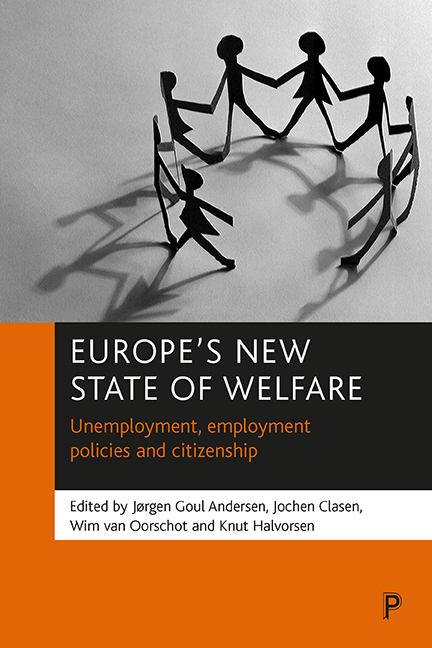Book contents
- Frontmatter
- Contents
- Notes on contributors
- Glossary
- Preface
- one Changing labour markets, unemployment and unemployment policies in a citizenship perspective
- two Employment and unemployment in Europe: overview and new trends
- three Unemployment and unemployment policy in the UK: increasing employability and redefining citizenship
- four To be or not to be employed? Unemployment in a ‘work society’
- five France: the impossible new social compromise?
- six Labour market participation in the Netherlands: trends, policies and outcomes
- seven Is high unemployment due to welfare state protection? Lessons from the Swedish experience
- eight Denmark: from the edge of the abyss to a sustainable welfare state
- nine Unemployment and (un)employment policies in Norway: the case of an affluent but oil-dependent economy: the paradox of plenty?
- ten Unemployment and unemployment policy in Finland
- eleven Slovenia’s navigation through a turbulent transition
- twelve Unemployment and unemployment policy in Switzerland
- thirteen Work, welfare and citizenship: diversity and variation within European (un)employment policy
- References
- Index
- Also available from The Policy Press
three - Unemployment and unemployment policy in the UK: increasing employability and redefining citizenship
Published online by Cambridge University Press: 20 January 2022
- Frontmatter
- Contents
- Notes on contributors
- Glossary
- Preface
- one Changing labour markets, unemployment and unemployment policies in a citizenship perspective
- two Employment and unemployment in Europe: overview and new trends
- three Unemployment and unemployment policy in the UK: increasing employability and redefining citizenship
- four To be or not to be employed? Unemployment in a ‘work society’
- five France: the impossible new social compromise?
- six Labour market participation in the Netherlands: trends, policies and outcomes
- seven Is high unemployment due to welfare state protection? Lessons from the Swedish experience
- eight Denmark: from the edge of the abyss to a sustainable welfare state
- nine Unemployment and (un)employment policies in Norway: the case of an affluent but oil-dependent economy: the paradox of plenty?
- ten Unemployment and unemployment policy in Finland
- eleven Slovenia’s navigation through a turbulent transition
- twelve Unemployment and unemployment policy in Switzerland
- thirteen Work, welfare and citizenship: diversity and variation within European (un)employment policy
- References
- Index
- Also available from The Policy Press
Summary
Introduction
For most of the past three decades the UK has ranked among the countries with one of the worst labour market records in Western Europe. Unemployment rates hovered around the 12% mark for most of the 1980s. For a very long time, the prospect for a return to anything approximating full employment seemed very bleak indeed. Any improvements turned out to be temporary and the persistence of high levels of unemployment became an all but accepted characteristic of late 20th century Britain.
Then, in 1993, unemployment started to fall gradually but steadily. At the same time employment levels started to climb. This time the improvement was long-lasting and non-inflationary, so that at the start of the 21st century, the UK can be considered as one of the labour market ‘success’ countries in Europe next to Denmark, the Netherlands and Ireland (see Chapter Two of this volume). While other countries (Austria and Luxembourg in particular) have lower unemployment, it is these four countries which have witnessed significant reductions of unemployment during the last decade. What is more, among the large economies in Europe, the UK is the only one that can boast a sustained labour market improvement, while Italy, Germany and France are now faced with the highest unemployment rates in Western Europe.
On the face of it, the turnaround in the British labour market is remarkable indeed. By the end of the 1990s, the labour force participation rate of those aged 16-64 reached 76% – a higher figure than that for the mid 1970s. This was largely due to women entering the labour market to an extent which is now close to levels found in Scandinavia. By contrast, as in many other countries, the labour force participation among men dropped over the past three decades. However, this trend seems to have slowed down in the mid-1990s and the current rate of 84% is one of the highest in Europe and certainly higher than in any other large European economy.
Equally, unemployment levels dropped to the lowest levels since the early 1980s, with 1.47 million people out of work in spring 2001, which represented just below 5.0% of the workforce according to the ILO definition, which is now the government’s preferred measure.
- Type
- Chapter
- Information
- Europe's New State of WelfareUnemployment, Employment Policies and Citizenship, pp. 59 - 74Publisher: Bristol University PressPrint publication year: 2002
- 2
- Cited by



